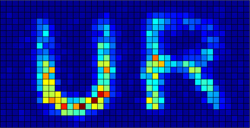 |
| False color representation of the delayed low-light-level image (Credit University of Rochester) |
| Download hi-res UR image Diagram of the encoding device |
Researchers at the University of Rochester have demonstrated that optical pulses in an imaging system can be buffered in a slow-light medium, while preserving the information of the image.
The ability to delay an entire image and retrieve it intact opens a new avenue in optical buffering—short-term storage of information as optical images. While the initial test image consists of only a few hundred pixels, a tremendous amount of information can be buffered with the new technique.
Slow-light systems have been a topic of recent interest because of their potential application in signal-processing, including all-optical buffers. University scientists used a dilute cesium vapor inside a four-inch glass cell with temperatures at about the boiling point of water to slow the light.
Much of the research into slow-light buffers has been to delay binary signals. The Rochester group demonstrated that entire images can also be buffered.
"Instead of delaying ones and zeros, we're delaying an entire image," says John Howell, assistant professor of physics and leader of the team that created the device, described in the Jan. 22 online issue of the journal Physical Review Letters. "It's analogous to the difference between snapping a picture with a single pixel and doing it with a camera—this is the optical-buffering equivalent of a six-megapixel camera."
The researchers use very weak pulses, which are three meters long and a few millimeters in diameter. Each pulse contains less than one photon on average, which means sometimes no photons will be detected, sometimes one photon will be detected, and occasionally multiple photons will be detected. Every second, three million pulses pass through a stencil with the letters "UR" for the University of Rochester. The pulses travel through the cesium vapor where they are slowed up to 300 times slower than in air.
The image of the stencil is formed by scanning a fiber across the imaging plane. The fiber collects image information one pixel at a time. Over a hundred million pulses were used to reconstruct the image.
"The parallel amount of information John has sent all at once in an image is enormous in comparison to what anyone else has done before."
"When we turned the power of the pulses up so that we had many photons per pulse, we used a CCD camera, rather than a scanning fiber, to show that much higher resolution images could be formed in the system," says Irfan Ali-Khan, a co-author on the paper. "Additionally, we were able to demonstrate that the phase of the image was also preserved, which is an exciting result."
"You can have a tremendous amount of information in a pulse of light, but normally if you try to buffer it, you can lose much of that information," says Ryan Camacho, Howell's graduate student and lead author on the article. "We're showing it's possible to pull out an enormous amount of information with a high signal-to-noise ratio even with very low light levels."
Howell's group used a completely new approach that preserves the properties of the pulse. The buffered pulse is essentially a near-perfect original; there is almost no distortion, no additional diffraction, and the phase and amplitude of the original signal are all preserved.
"The implication is that things like photonic entanglement will also remain intact," says Curtis Broadbent, co-author on the paper. "If that's the case, and we're working on showing that now, this approach may prove to be useful in quantum information settings."
"The parallel amount of information John has sent all at once in an image is enormous in comparison to what anyone else has done before," says Alan Willner, professor of electrical engineering at the University of Southern California and president of the IEEE Lasers and Optical Society. "To do that and be able to maintain the integrity of the signal—it's a wonderful achievement."
Howell has so far been able to delay light pulses 100 nanoseconds and compress them to 1 percent of their original length. He is now working toward delaying pulses by dozens of pulse lengths for as long as several milliseconds, and delaying terahertz bandwidth pulses by well over 1,000 pulse lengths.
